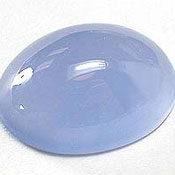Chalcedony
(kal-sed-n-ee)
HISTORY and LORE
- Though not familiar by name, an old and illustrious gem family. Treasured by humans since prehistoric times, chalcedonies were sacred and royal gemstones in early civilizations around the world.
- Named for Chalcedon, an ancient trade center located in what is now Turkey.
- Long used in Europe as a charm against ghosts.
VALUE FACTORS
- Color: Range is almost unlimited. Many natural colors, and others from treatment.
- Clarity: Translucent to opaque.
- Cut: Cabochons, carvings, tablets, and beads in many shapes.
- Size/Weight: many varieties are available in all sizes, and occur in pieces big enough for large carvings or other ornamental uses. (Normally not priced or sold by carat weight.)
TREATMENT
- Often dyed, and in a wide variety of colors. Some techniques have been used since Roman times. The effects are normally permanent, and the treatment creates no special care requirements.
GEMOLOGY
- A mineral species closely related to quartz. In fact, mineralogists consider it a quartz variety. Composed mostly of silicon and oxygen: chemical formula SiO2, which is the same as quartz.
- Agate, bloodstone, carnelian, onyx, and sardonyx are well known chalcedony varieties. Others include:
Amethystine chalcedony – purple
Chrysocolla chalcedony – bright blue or blue-green
Chrysoprase – light yellowish green
Plasma – dark green with white or yellow spots
Prase – dark green
Sard – dark orange, brownish red, or brown
CARE
Chalcedony generally has good wearability.
- Hardness: Moderate scratch resistance. Rates 6.5 to 7 on the Mohs Hardness Scale.
- Toughness: Good resistance to chipping and breaking.
- Stability: If dyed, color may eventually fade.
- Cleaning: Liquid cleaner, or detergent and water. Ultrasonic is usually safe.
